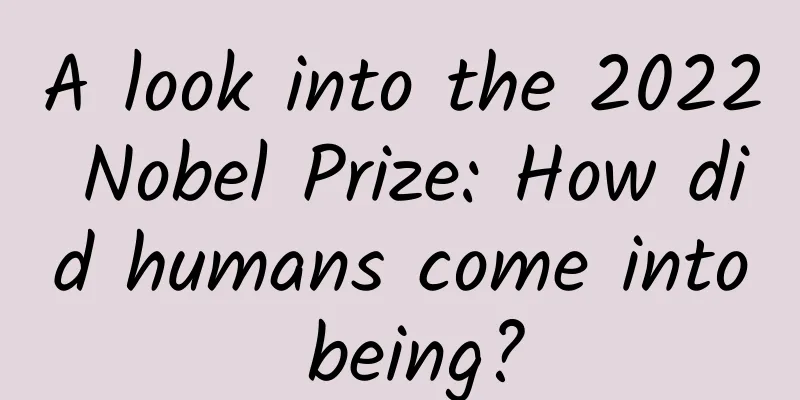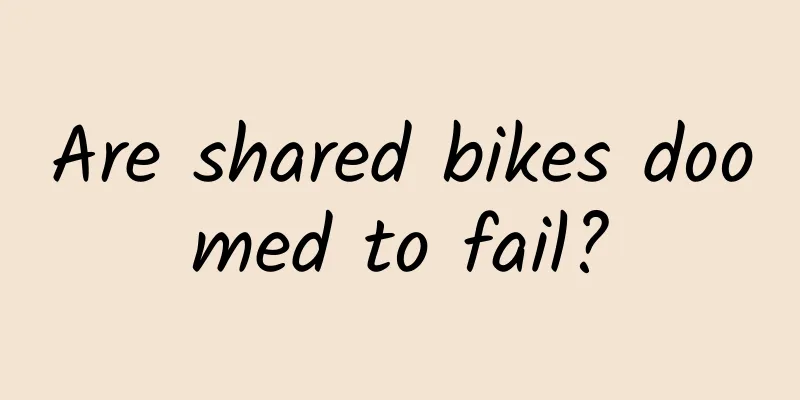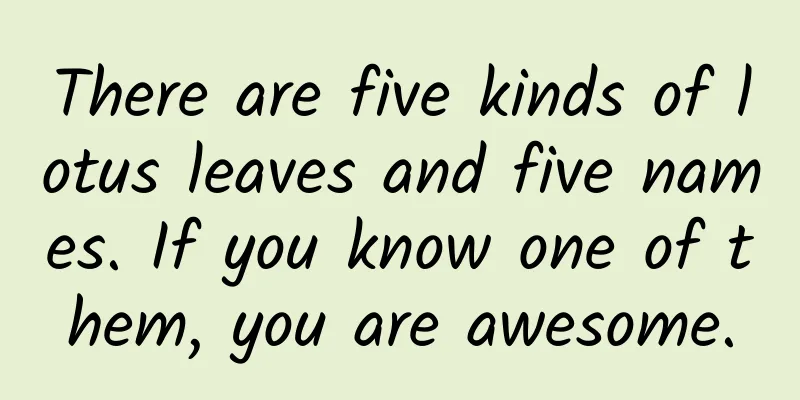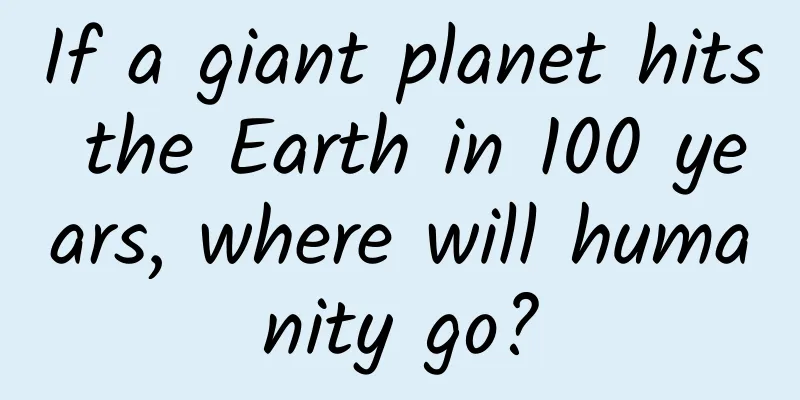A look into the 2022 Nobel Prize: How did humans come into being?

|
At 11:30 a.m. on October 3, 2022, local time in Sweden (17:30 p.m. on October 3, Beijing time), the Nobel Prize Committee announced that the 2022 Nobel Prize in Physiology or Medicine will be awarded to Swedish biologist and evolutionary geneticist Svante Pääbo in recognition of his discovery of the genome related to extinct ancient humans and human evolution. Today, an old article published in Fanpu in 2019 once again looks at the 2022 Nobel Prize in Physiology or Medicine. Written by | Tang Bo While the box office of the Chinese science fiction film "The Wandering Earth" has exceeded 4 billion yuan, many movie fans still remember the American fantasy film "Aquaman" which was released more than two months ago. At present, the global box office of the film has exceeded 1.13 billion US dollars, of which the Chinese market contributed about 300 million US dollars, ranking among the top 20 best-selling films in the world's history. In the story told in "Aquaman", the Queen of Atlantis fell in love with an American lighthouse keeper and gave birth to a boy named Arthur. With the help of Princess Mera (Orm's fiancée), Arthur fought against his brother Orm, who wanted to rule the ocean and annex the land. In the end, he defeated the powerful Orm and became the King of the Sea who ruled the seven seas. Aquaman Arthur Curry To his brother Orm, who was born in the sea, Arthur was just a "hybrid" who was half land and half sea. Orm did not take his brother Arthur seriously at first, but it was Arthur, the hybrid, who defeated him, took back the throne, and won the beauty. Such stories are common in Chinese and foreign myths and literary works. Although they are fictional, they contain profound scientific truths, that is, the performance of hybrids is sometimes better than that of purebreds. Since Gregor Mendel, an Austrian priest and the father of modern genetics, discovered this law of life inheritance through his pea experiment, geneticists and breeders have developed a series of hybrid crops and new animal varieties. Hybrids have become the main force of agricultural production. It is these hybrids that feed such a large population and countless domestic animals on the earth. Plants and animals are not to be mentioned. Even humans themselves have benefited from hybrid vigor and have prospered and evolved to become the masters of the earth. Today, let’s talk about the history of human “hybrid” development. Out of Africa About 7 million years ago, somewhere in Africa, human ancestors parted ways with apes and began their unique evolutionary path of making tools, walking upright, speaking, and telling stories. Afterwards, the ancestors of humans such as Australopithecus, Homo habilis and Homo ergaster gradually spread throughout Africa; due to food shortages or the instinct of animal curiosity, more than 1 million years ago, the truly upright Homo erectus began to walk out of Africa and advance into the Eurasian continent. These Homo erectus included Yuanmou Man, Lantian Man and Peking Man who lived in the vast land of China, but these early humans who walked out of Africa became extinct one after another and are not the direct ancestors of modern humans. For decades, most scientists studying human evolution believed that modern humans originated from a single population that remained somewhere in southern Africa. About 200,000 years ago, this human branch began to evolve rapidly and became the direct ancestor of modern humans, Homo sapiens. However, this theory is being strongly challenged by some new discoveries. In June 2017, an international research team led by Dr. Jean-Jacques Hublin of the Max Planck Institute for Evolutionary Anthropology in Germany published two important papers back to back in the journal Nature. They discovered a 315,000-year-old Homo sapiens skull in a cave in Morocco, northern Africa. This not only pushed the history of modern humans back 100,000 years, but also inferred that Homo sapiens did not originate from a single source in southern Africa, but was a mixture of different races in many parts of Africa. In other words, Homo sapiens had already begun "hybridization" before leaving Africa, so that the "hybrid" offspring could leave Africa and travel to every corner of the earth. After living and multiplying in Africa for 200,000 to 300,000 years, these ancestors of modern humans, like their earlier human ancestors, could not escape the temptation of curiosity and food, and kept trying to leave Africa. Finally, 50,000 years ago, a small group of modern human ancestors were lucky enough to achieve an unprecedented victory. The reason why modern human ancestors were able to achieve evolutionary success, in addition to their own efforts, was also due to the help of the descendants of Homo erectus who walked out of Africa early, including genetic contributions. About 50,000 to 100,000 years ago, modern human ancestors walked out of Africa and first encountered some mysterious human races that evolved from Homo erectus and were familiar with and adapted to the Eurasian environment. They started a love-hate relationship with these mysterious human races for thousands of years, which created us, the only one among the hominids today. Falling in love with a big-brained Neanderthal In 1856, three years before Darwin published The Origin of Species, workers found a human skull and some bones in a quarry in the Neander Valley, 12 kilometers east of Düsseldorf, Germany. Archaeologists identified them as the remains of an extinct human race, which scientists called "Neanderthals." Later, archaeologists excavated hundreds of Neanderthal remains from Europe and the Middle East. Neanderthals were anatomically distinct from early Homo sapiens: They had short, stocky bodies, light skin, and, more unusually, larger brains than our modern human ancestors. They made stone tools, used fire, and may have developed a culture that allowed them to bury their loved ones. Modern human skull and Neanderthal skull (Source: theverge.com) Neanderthal skeleton source: wiki Scientists have been arguing about the taxonomic status of Neanderthals. Some believe that Neanderthals belong to a completely different race from Homo sapiens, while others believe that Neanderthals also belong to Homo sapiens and are a subspecies under it. Most scientists generally believed that Neanderthals made no genetic contribution to modern humans until the first Neanderthal genome draft was published in 2009. On February 12, 2009, an international research team led by Svante Pääbo of the Max Planck Institute for Evolutionary Anthropology in Germany announced that they had deciphered the draft of the Neanderthal genome for the first time. The genomic DNA was extracted from three small bones belonging to different Neanderthals, which were unearthed from the Vindiga Cave in northern Croatia. The Neanderthal genome information released this time totals about 2 billion base pairs, accounting for about 60% of its entire genome. What is even more shocking is that scientists have found that the European and Asian populations actually contain 1-4% of the Neanderthal-specific genomic information, while the native Africans do not, indicating that modern humans interbred with Neanderthals after leaving Africa, and the offspring of these interbreedings became the ancestors of modern humans. Scientists chose to publish the draft of the Neanderthal genome they drew on February 12, mainly to commemorate the 200th anniversary of the birth of Darwin, the founder of the theory of evolution. In May 2010, detailed information on the draft Neanderthal genome was officially published in the journal Science. Neanderthal skull and Professor Svante Pääbo (Photo: The Washington Post) Four years later, the research team excavated a Neanderthal toe bone from a cave called Denisova in the Altai Mountains in southern Siberia, Russia, extracted genomic DNA from it, measured the entire genome of the Altai Neanderthal, and found that only 1.5-2.1% of Neanderthal genetic information is contained in the modern human genome. In 2017, a paper in Science magazine stated that the proportion of Neanderthal genetic information in the genome of East Asians is slightly higher than that of Western Europeans, with 2.3-2.6% of the genome of East Asians coming from Neanderthals, while Neanderthals only contribute 1.8-2.4% to the genome of Western Europeans. Scientists speculate that Neanderthals lived in Eurasia about 400,000 to 40,000 years ago, and early modern humans left Africa about 50,000 years ago. Many studies have shown that it was 50,000 to 60,000 years ago, when early modern humans had just left Africa and set foot on the land of the Middle East, that they encountered Neanderthals living nearby. The two sides may have lived together in Eurasia for up to 5,000 years. There is no direct evidence of whether there was a large-scale conflict between the two sides, but by comparing the genetic information of ancient humans, scientists speculate that Neanderthals and early modern humans often fell in love with each other and mixed with each other. In 2015, Dr. Fu Qiaomei from the Institute of Vertebrate Paleontology and Paleoanthropology, Chinese Academy of Sciences, as the first author, wrote in the journal Nature that researchers analyzed the DNA of a male early modern human unearthed in Romania, dating back about 40,000 years, and found that the Neanderthal-specific genomic information accounted for as much as 9% of the genome of the modern human. In other words, one of the man's great-great-grandparents may have been a Neanderthal. This is also the closest early modern human to Neanderthals that scientists have discovered so far. In fact, early modern humans not only received the genetic gift from Neanderthals, but also successfully passed on their own genetic information to Neanderthals 100,000 years ago. In February 2016, researchers from an international team including the Max Planck Institute for Evolutionary Anthropology in Germany announced in the journal Nature that they had detected for the first time the genetic information unique to the ancestors of modern humans in the genome of a female Neanderthal in a remote cave in the Altai Mountains of Russia. They speculated that a small group of ancestors of modern humans had interbred with East Asian Neanderthals 100,000 years ago, but later these modern human genetic information disappeared without a trace. Colluding with the mysterious 'Denisovans' However, it was not only Neanderthals that had genetic exchanges with the ancestors of modern humans. Let’s go back to the Denisova Cave in the Altai Mountains, located at the border of Russia, China, and Mongolia. Not only did Neanderthals live here, but they also sheltered the ancestors of modern humans, and a mysterious human race also lived here. Just a month before the first draft of the Neanderthal genome was published in Science, a team led by Svante Paabo of the Max Planck Institute for Evolutionary Anthropology and Anatoli P. Derevianko of the Russian Academy of Sciences wrote in Nature that they had discovered another extinct new species of human. The researchers conducted a genetic analysis of mitochondrial DNA from a small piece of finger bone that Derevianko excavated from the Denisova Cave two years ago. They extracted mitochondrial DNA from the small bone and sequenced it. By comparing it with the mitochondrial DNA of early modern humans, Neanderthals, bonobos and chimpanzees, they were surprised to find that the small bone fragment did not belong to early modern humans, Neanderthals, bonobos or chimpanzees. Further analysis revealed that the owner of this small bone fragment shared the same ancestor with early modern humans and Neanderthals one million years ago. The researchers therefore speculated that this small bone fragment belonged to a new extinct human species. At the end of 2010, the research team further analyzed the genomic DNA of this finger bone and speculated that this new human species is closely related to Neanderthals and may have been one family 640,000 years ago, and the time of divergence from modern Africans may be 840,000 years ago. Molars that confirm the identity of "Denisovans" (Source: David Reich et al., 2010) Soon, researchers excavated other bone fragments belonging to different individuals in the same cave, all of which had a similar genetic background to this new human species, so they called it "Denisovans". Denisovans are close relatives of Neanderthals, with about 17% of their genetic information coming from the latter. In August 2018, according to a report in Nature magazine, an international research team led by Viviane Slon and Svante Pääbo of the Max Planck Institute for Evolutionary Anthropology in Germany analyzed a small piece of bone from the Denisova Cave in the Altai Mountains of Russia and found that the bone belonged to a girl who was at least 13 years old 90,000 years ago. What's more surprising is that her mother was a Neanderthal and her father was a Denisovan. This is the first time that scientists have discovered direct hybrids between Neanderthals and Denisovans, indicating that it is very common for these different races to mix with each other after they meet. Denisovans may have interbred with modern humans later than Neanderthals, and their genes are not as widely distributed as the latter. Denisovan genetic information is mainly retained in the genomes of modern Asians, among which the genomes of Melanesians living on Pacific islands near Southeast Asia contain 4-6% Denisovan genetic information. A 2016 study reduced this proportion to 1.1%, and speculated that another extinct human may have contributed genetic information. Other researchers have found that some indigenous peoples in Australia and scattered islands in Southeast Asia, as well as indigenous peoples in East Asia and the Americas, have Denisovan contributions in their genomes. In March 2018, researchers from the University of Washington in Seattle and Princeton University wrote in the journal Cell that they used a new reference genome-free detection method to analyze 5,639 human whole genome sequences from Eurasia and Oceania, and found that the genetic information left by the Denisovans in East Asian populations was significantly different from that in South Asians and Oceania populations. Therefore, they speculated that the Denisovans and modern humans had interbred at least twice, which made the mixing of modern humans and other ancient humans more complicated. So far, scientists have only found the remains of the Denisovans in the Denisova Cave in the Altai Mountains of Russia, and they are all small bone fragments, and no relatively complete remains have been found, which makes it difficult for scientists to speculate what the Denisovans looked like, not to mention their living habits, living areas, etc. However, like Neanderthals, they interbred with the ancestors of modern humans, leaving their genetic information forever in a part of the modern human genome, and brought unexpected benefits to these modern humans to adapt to the environment and eventually become the masters of the earth. Get rid of the false and keep the true, and become a strong person During the years of living together with the ancestors of modern humans, due to climate deterioration and other reasons, Neanderthals and Denisovans also accumulated a large number of harmful gene mutations, which were inevitably passed on to their offspring who hybridized with modern humans. Although not all the genetic gifts obtained from Neanderthals, Denisovans and other races are beneficial to modern humans, modern humans have gradually eliminated unfavorable genes and retained favorable genes in their short evolutionary history, which enabled them to climb plateaus, swim on Shanghai and islands, travel around the world, and even explore the universe. As we all know, when the ancestors of modern humans just walked out of Africa 50,000 years ago, Neanderthals and Denisovans had already lived in Eurasia for more than 300,000 years, evolving strong adaptability to the local climate, food, pathogenic microorganisms and other environments, and eventually formed some unique genotypes adapted to the environment. The mixing of modern humans with these ancient humans is conducive to the introduction of the corresponding favorable genotypes of these ancient humans, which obviously can help the newly arrived modern humans quickly adapt to the environment, such as the cold climate in Europe, and then spread all over the world. Researchers from Shenzhen BGI Genomics Institute, University of California, South China University of Technology and other institutions found that the reason why Tibetans in China can adapt to the high-altitude and low-oxygen environment of more than 4,000 meters in Tibet may be because Tibetans inherited a EPAS1 gene mutation related to low-oxygen adaptation from the Denisovans or their close relatives. The research results were published in the journal Nature in July 2014. Researchers at the Max Planck Institute for Evolutionary Anthropology in Germany analyzed the genomes of 112,000 British people and found that some genes related to skin color, hair color, height, sleep patterns and even smoking status came from Neanderthals. In October 2018, David Enard from the University of Arizona and Dmitri A. Petrov from Stanford University reported in the journal Cell that during the interbreeding process, Neanderthals and ancient Homo sapiens not only spread viruses to each other, but also passed on the virus-interacting protein (VIP) gene to the offspring of the two interbreeding. VIP protein has multiple functions, such as participating in immune response and resisting the invasion of specific viruses, especially RNA viruses. Due to gene mutations, some Neanderthal VIP proteins can resist certain specific viruses, especially RNA viruses. In this way, the descendants of Homo sapiens who inherited the Neanderthal VIP gene will gain resistance to more viruses, that is, genetic adaptability, and survive the subsequent large-scale plague, while those non-interbreeding offspring will be gradually eliminated. Dr. Jennifer Raff, a contributor to Forbes, vividly likened this phenomenon to Neanderthals and ancient Homo sapiens both poisoning each other and providing each other with antidotes. Neanderthals and modern human ancestors poisoned each other and provided each other with "antidotes" (Image source: David Enard et al., 2018, Cell) Although Neanderthals and Denisovans have become completely extinct as human races, their love story with the ancestors of modern humans has been deeply engraved in our genome and can never be erased. References 1. Alexander H. Harcourt, The Evolution of Humankind: From Out of Africa to Dominating the Earth[M]. Beijing, CITIC Press, 2017. ISBN:9787508678962. 2. Svante Pääbo, Neanderthals, translated by Xia Zhi. Hangzhou, Zhejiang Education Press, 2018. ISBN: 9787553678351. 3. Hublin JJ, Ben-Ncer A, Bailey SE, et al., New fossils from Jebel Irhoud, Morocco and the pan-African origin of Homo sapiens. Nature. 2017, 546(7657): 289-292. 4. Richter D, Grün R, Joannes-Boyau R, et al. The age of the hominin fossils from Jebel Irhoud, Morocco, and the origins of the Middle Stone Age. Nature. 2017, 546(7657):293-296. 5. Richard E. Green, Johannes Krause, Adrian W. Briggs et al. A Draft Sequence of the Neandertal Genome. Science. 2010, 328(5979):710-722. 6. Kay Prufer, Fernando Racimo, Nick Patterson et al. The complete genome sequence of a Neanderthal from the Altai Mountains. Nature. 2014, 505(7481):43-9. 7. Prüfer K, de Filippo C, Grote S, et al. A high-coverage Neandertal genome from Vindija Cave in Croatia. Science. 2017, 358 (6363): 655–58. 8. Qiaomei Fu, Mateja Hajdinjak, Oana Teodora Moldovan, et al., An early modern human from Romania with a recent Neanderthal ancestor. Nature. 2015, 524: 216–219. 9. T. Higham, K. Douka, R. Wood, et al. The timing and spatiotemporal patterning of Neanderthal disappearance. Nature. 2014, 512(7514): 306–09. 10. Johannes Krause, Qiaomei Fu, Jeffrey M. Good, et al. The complete mitochondrial DNA genome of an unknown hominin from southern Siberia. Nature. 2010, 464: 894–897. 11. Reich David, Green Richard Kircher Martin, et al. Genetic history of an archaic hominin group from Denisova Cave in Siberia. Nature. 2010, 468 (7327): 1053–60. 12. Browning SR, et al. Analysis of Human Sequence Data Reveals Two Pulses of Archaic Denisovan Admixture. Cell. 2018, 173(1): 53-61. 13. Viviane Slon, Fabrizio Mafessoni, Benjamin Vernot, et al. The genome of the offspring of a Neanderthal mother and a Denisovan father. Nature. 2018, 561:113–116. 14. Huerta-Sa´nchez E, Jin X, Asan, Bianba Z, et al. Altitude adaptation in Tibetans caused by introgression of Denisovanlike DNA. Nature. 2014, 512:194-197. 15. Dannemann M, Kelso J. The contribution of Neanderthals to phenotypic variation in modern humans. Am J Hum Genet. 2017, 101:578-589. 16. Enard D. and Petrov DA Evidence that RNA Viruses Drove Adaptive Introgression between Neanderthals and Modern Humans. Cell. 2018, 175(2): 360-371. We would like to thank Dr. Fu Qiaomie for reviewing and revising this article. Special Tips 1. Go to the "Featured Column" at the bottom of the menu of the "Fanpu" WeChat public account to read a series of popular science articles on different topics. 2. Fanpu provides a function to search articles by month. Follow the official account and reply with the four-digit year + month, such as "1903", to get the article index for March 2019, and so on. Copyright statement: Personal forwarding is welcome. Any form of media or organization is not allowed to reprint or excerpt without authorization. For reprint authorization, please contact the backstage of the "Fanpu" WeChat public account. |
<<: Have you ever seen a guy with afro who can walk 20 kilometers a day?
>>: 49 million years ago, a plant overran the frozen Earth
Recommend
What is it like to drive a new energy vehicle?
Recently, a friend of mine wants to buy a car. I&...
Safety of GM's 'Super Cruise' semi-autonomous driving system questioned
According to Reuters, the U.S. Highway Traffic Sa...
Pain points of K12 online education industry and 3 solutions
The 2020 epidemic “black swan” event has pushed o...
110, happy holidays!
“I am a police officer” Anytime, Anywhere Hear th...
The future of mobile app development from the history of middleware
[[149563]] In the field of mobile development, we...
What's the matter with the "mysterious patterns" on the back of the chair? Is there a bug in the world?
What's the matter with the "mysterious p...
This seasoning is toxic and carcinogenic after heating? You may have been deceived for too many years...
In recent years, MSG has disappeared from many pe...
A complete guide to advertising on TikTok!
You may be running campaigns on more established ...
Do a physical examination for the mountains and rivers? How to do this physical examination?
On May 12, 2023, the Science Popularization China...
Chengdu and Chongqing: Dinosaurs are everywhere
The Sichuan Basin lies between Chengdu and Chongq...
Analyze user retention from user motivation!
At the current stage, the cost of acquiring custo...
Advertising response strategies for 6 major industries during the epidemic!
At the beginning of 2020, the sudden outbreak of ...
Jiangsu's latest maternity leave 2022 policy document: When will the extension of 158 days be implemented?
Starting from the end of 2021, many provinces hav...
Smart TV: Don’t let intelligence become a “burden”
Smart TVs have gradually become the mainstream in...
Apple's trillion-dollar market value may be its last
[[248882]] Image source: Visual China While we st...









